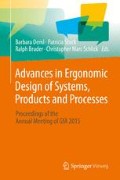Abstract
The collection and analysis of applied forces is an essential part of the ergonomic evaluation of workplaces. In industrial companies, direct measurements and estimates are currently considered to be accepted methods. The present study identifies alternatives to the accepted procedures for the determination of action-forces and analysed one of these in detail: force-matching.
Force-matching describes the immediate subsequent simulation of an exertion on a measuring device, without actually assembling a component. In this way, cost and time savings in comparison to the direct measurement can be achieved. Furthermore, the method increases accuracy compared to estimations. To validate the applicability, a study involving 38 subjects was carried out in order to achieve a systematic comparison between force-matching and direct measurement.
In the course of the evaluation, influence factors and key premises for the utilisation of the new method in the automotive industry are identified. The results indicate that force-matching has great potential for improving quantity and quality in the determination of applied forces in ongoing production.
Access this chapter
Tax calculation will be finalised at checkout
Purchases are for personal use only
References
Bao S, Silverstein B (2005) Estimation of hand force in ergonomic job evaluations. Ergonomics 48(3):288–301
Bao S, Spielholz P, Howard N, Silverstein B (2006) Quantifying repetitive hand activity for epidemiological research on musculoskeletal disorders – part I: individual expo-sure assessment. Ergonomics 49(4):361–380
Borg GA (1982) Psychophysical bases of perceived exertion. Med Sci Sports Exerc 14(5):377–381
Casey JS, McGorry RW, Dempsey PG (2002) Getting a Grip on Grip Force Estimates. In: Professional Safety 47(10), p. 18
Gandevia SC, Kilbreath SL (1990) Accuracy of weight estimation for weights lifted by proximal and distal muscles of the human upper limb. J Physiol 423:299–310
Jung K, You H, Kwon O (2006) Evaluation of the FSA Hand Force Measurement System. Proc Hum Factors Ergon Soc Annu Meet 50(4):2577–2581
Kroemer K (1977) Die Messung der Muskelstärke des Menschen. Wirtschaftsverlag NW, Bremerhaven
Schaub K, Caragnano G, Britzke B, Bruder R (2013) The European Assembly Worksheet. Theor Issues Ergon Sci 14(6):616–639
Walther M (2015). Entwicklung und Evaluierung eines systematischen Vorgehens zur Erfassung von Aktionskräften in der Automobilproduktion. Dissertation, Technische Universität Chemnitz, Professur Arbeitswissenschaft (Unpublished)
Walther M, Kunze T, Toledo Munoz B, Büttner B, Kaiser A, Bullinger A (2013) Kraftmessungen an Schnappverbindungen in der Automobilproduktion. Chancen durch Arbeits-, Produkt- und Systemgestaltung – Zukunftsfähigkeit für Produktions- und Dienstleistungsunternehmen. GfA-Press, Dortmund, pp 237-240
Wiktorin C, Selin K, Ekenvall L, Kilbom A, Alfredsson L (1996) Evaluation of perceived and self-reported manual forces exerted in occupational materials handling. Appl Ergon 27:231–239
Acknowledgements
Special thanks to Dr. Sonja Schmicker, Mr. Ulrich Brennecke and Mr. Stefan Wassmann from the Institute of Ergonomics, Manufacturing Systems and Automation (IAF) at the Otto-von-Guericke University Magdeburg for the constructive cooperation.
Author information
Authors and Affiliations
Corresponding author
Editor information
Editors and Affiliations
Rights and permissions
Copyright information
© 2016 Springer-Verlag Berlin Heidelberg
About this paper
Cite this paper
Franzke, B., Walther, M. (2016). Force-Matching. A New Approach to Determine Action Forces for the Ergonomic Evaluation in Automotive Industry. In: Deml, B., Stock, P., Bruder, R., Schlick, C.M. (eds) Advances in Ergonomic Design of Systems, Products and Processes. Springer Vieweg, Berlin, Heidelberg. https://doi.org/10.1007/978-3-662-48661-0_24
Download citation
DOI: https://doi.org/10.1007/978-3-662-48661-0_24
Publisher Name: Springer Vieweg, Berlin, Heidelberg
Print ISBN: 978-3-662-48659-7
Online ISBN: 978-3-662-48661-0
eBook Packages: EngineeringEngineering (R0)

